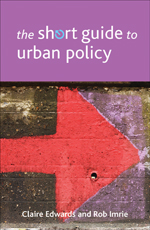The short guide to urban policy

This guide manages to concisely describe urban policies dealt with by government and non-governmental actors. These shape and are shaped by numerous social, economic, political and ecological challenges that are particular to urban living.
Questioning and elaborating on different visions of a good city and good citizens, with a spatial and temporal focus on the UK and US from the late 1960s on, the authors make it clear that urban policy cannot be politically neutral or value-free. Rather, it has to take place within struggles over the form and substance of urban space, whose outcomes essentially determine how far the policy is made for people or profit.
The first chapters introduce readers to the challenges and contradictions of urban living, as well as how urban policy discourses evolved in complex relation to cities’ subjects and objects. Also described are different theoretical schools and developments like the City Beautiful Movement, and urban regeneration efforts and programmes to address social exclusion. Chapter 3 then asks “whose right to the city” is at stake, and therefore addresses the socio-political values, norms and practices that are fundamental to urban policy. Here, these questions provide the basis for the chapters looking at particular actors and their interests, such as market actors, privatism and urban entrepreneurialism (Chapter 4) and community planning and partnerships (Chapter 5, where a particular highlight is the elaboration of the concept of community).
Culture as well as sustainable development have important roles in urban policy making, especially because cities have great potential for stimulating and guiding creative and sustainable solutions. However, they are also threatened by commodification and urban competition, as can for example be observed by gentrification of artistic quarters or sustainability as a marketing strategy that increases consumption. The authors end the book with a discussion of the future of cities and of urban policy in light of austerity and the economic developments of recent years that saw cuts in public spending, widening income inequalities, and the advance of private urban governance.
The style and structure of the book make it engaging reading, particularly because the chapters build on a variety of case studies, suggest recommended readings and provide web links, which all provide useful resources for readers seeking to enter the urban policy field in the context of Western cities.
Book note prepared by Julia Wesely
Search the Book notes database
Our Book notes database contains details and summaries of all the publications included in Book notes since 1993 - with details on how to obtain/download.
Use the search form above, or visit the Book notes landing page for more options and latest content.
For a searchable database for papers in Environment and Urbanization, go to http://eau.sagepub.com/

